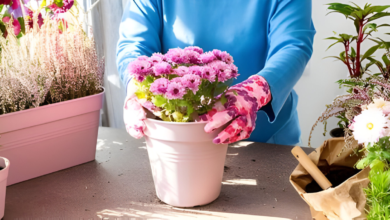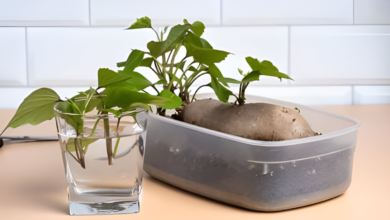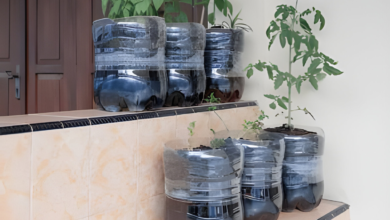5 Tips for Watering Tomatoes in Pots

Table of Contents:
- Importance of Proper Watering for Tomatoes in Pots
- Choosing the Right Containers and Soil for Optimal Watering
- Determining the Correct Watering Schedule Based on Tomato Variety
- Utilizing Proper Watering Techniques to Maximize Tomato Growth
- Recognizing Signs of Overwatering or Underwatering in Tomato Plants
- The Role of Mulching in Water Retention for Potted Tomatoes
- Understanding the Impact of Temperature on Watering Needs for Tomatoes
- Tips for Watering Tomatoes during Different Growth Stages
- Dealing with Common Watering Issues and How to Address Them
- Final Thoughts on Achieving Success in Watering Tomatoes in Pots
Importance of Proper Watering for Tomatoes in Pots
I cannot overemphasize the importance of proper watering when it comes to growing tomatoes in pots. Here are some key reasons why it is crucial:
- Prevents Overwatering: By watering your tomato plants correctly, you avoid the risk of overwatering, which can lead to root rot and other diseases. Overwatering deprives the roots of oxygen, causing them to suffocate and eventually die off.
- Promotes Healthy Growth: Proper watering ensures that your tomato plants receive the right amount of moisture to thrive. This helps in nutrient uptake and supports robust growth, leading to healthy leaves, flowers, and fruits.
- Prevents Blossom End Rot: Inconsistent watering, whether too much or too little, can result in blossom end rot, a common issue with tomatoes. Proper watering maintains soil moisture levels, reducing the chances of this condition occurring.
- Optimizes Nutrient Uptake: Water is essential for nutrient absorption by the plant roots. When you water your tomato plants correctly, you facilitate the uptake of essential nutrients, allowing for healthy development and better fruit production.
- Enhances Flavor: Believe it or not, the way you water your tomatoes can impact their flavor. Consistent and adequate watering helps in sugar production and accumulation in the fruits, enhancing their taste.
Proper watering is a fundamental aspect of tomato care, especially when they are grown in pots. By mastering this skill, you set your plants up for success and ensure a bountiful harvest of delicious tomatoes.
Choosing the Right Containers and Soil for Optimal Watering
When it comes to growing tomatoes in pots, selecting the right containers and soil is crucial for ensuring proper watering. Here are some tips on choosing the right containers and soil for optimal watering:
- Containers:
- Opt for containers that are at least 5 gallons in size to allow ample room for tomato roots to grow.
- Ensure the pots have drainage holes at the bottom to prevent waterlogging, which can lead to root rot.
- Consider using self-watering containers or containers with saucers to help maintain consistent moisture levels.
- Soil:
- Use a high-quality potting mix specifically formulated for container gardening.
- Look for mixes that are well-draining to avoid water retention issues.
- Consider adding organic matter like compost to improve soil structure and water retention.
By choosing the right containers and soil, you can create an optimal environment for your potted tomato plants to thrive and receive the right amount of water they need for healthy growth.
Determining the Correct Watering Schedule Based on Tomato Variety
I find it crucial to understand that different tomato varieties have varying needs when it comes to watering. Here are some general guidelines to help you determine the correct watering schedule based on the type of tomato you are growing:
- Determinate Tomatoes: These varieties tend to have a more compact growth habit and produce fruit all at once. For determinate tomatoes, I recommend watering consistently and deeply but allowing the soil to dry out slightly between watering sessions.
- Indeterminate Tomatoes: Indeterminate varieties continue to grow and produce fruit throughout the season. When it comes to watering indeterminate tomatoes in pots, I suggest keeping the soil consistently moist but not waterlogged. These plants may require more frequent watering, especially during hot weather.
- Heirloom Tomatoes: Heirloom tomatoes come in diverse shapes, sizes, and colors, often with unique flavors. To determine the correct watering schedule for heirloom varieties, I advise checking the soil moisture regularly to ensure it remains consistently moist but not overly saturated.
- Cherry Tomatoes: Cherry tomatoes are known for their small, sweet fruit and prolific production. When watering cherry tomatoes in pots, I find that keeping the soil consistently moist is key to supporting their continuous growth and fruiting.
- Hybrid Tomatoes: Hybrid tomato varieties are bred for specific traits like disease resistance or improved productivity. When watering hybrid tomatoes, I recommend following a watering schedule similar to that of determinate or indeterminate types based on the plant’s growth habits.
Remember, the specific environmental conditions in your area and the size of your tomato pot can also impact the plant’s watering needs. By observing your tomato plants closely and adjusting your watering routine based on the variety grown, you can promote healthy growth and bountiful harvests.
Utilizing Proper Watering Techniques to Maximize Tomato Growth
I always make sure to water my tomato plants thoroughly. This means watering until the water starts to drain from the bottom of the pot. By doing so, I ensure that the entire root system gets moisture and the plant can access water more efficiently.
I prefer watering my tomato plants in the morning. This allows the plants to absorb the water throughout the day, and any excess moisture can evaporate in the afternoon sunlight. Watering in the evening can lead to prolonged leaf wetness, which may encourage fungal diseases.
Mulching around the base of the tomato plant helps retain moisture in the soil. I use organic materials like straw or wood chips, which not only keep the soil moist but also add nutrients as they break down.
Pruning is essential for maximizing tomato growth. By removing lower leaves that may come in contact with the soil, I reduce the risk of soil-borne diseases. This practice also helps improve air circulation around the plant, reducing the likelihood of fungal issues.
I always monitor the soil moisture levels before watering again. Inserting my finger into the soil up to the first knuckle helps me determine if the soil is dry and in need of watering. This prevents overwatering, which can lead to root rot and other problems.
Maintaining a consistent watering schedule is key to ensuring healthy tomato plants. By following these proper watering techniques, I can maximize the growth and yield of my tomatoes.
Recognizing Signs of Overwatering or Underwatering in Tomato Plants
I can easily determine whether my tomato plants are overwatered or underwatered by closely observing the following signs:
- Overwatering Signs:
- Yellowing leaves that are wilting and may feel soft to the touch.
- Edema, visible as blisters or bumps on the leaves.
- Moldy or musty smell coming from the soil.
- Fungus gnats or mold growth on the soil surface.
- Underwatering Signs:
- Wilting leaves that are dry and brittle.
- Leaf margins turning brown and crispy.
- Slow or stunted growth of the plant.
- Dry soil that pulls away from the edges of the pot.
It is crucial to address these signs promptly to prevent any further damage to my tomato plants.
The Role of Mulching in Water Retention for Potted Tomatoes
Mulching is a helpful technique when it comes to conserving water for potted tomato plants. The layer of mulch serves as a protective barrier that helps to retain moisture in the soil, reducing the frequency of watering needed. Here’s why mulching is crucial for water retention for potted tomatoes:
- Conserves Moisture: Mulch acts as a protective layer that shields the soil from the sun’s heat, reducing evaporation. This helps to keep the soil consistently moist for longer periods, benefiting the potted tomatoes.
- Regulates Soil Temperature: By insulating the soil, mulch helps to moderate the temperature. This is important for potted tomatoes as extreme fluctuations in soil temperature can stress the plants and affect water uptake.
- Prevents Soil Compaction: Mulch also plays a role in preventing soil compaction. Compacted soil can hinder water absorption and root development in potted tomatoes. The mulch layer creates a buffer that maintains soil structure and promotes healthy root growth.
- Reduces Weed Growth: Mulching helps to suppress weed growth around potted tomatoes. Weeds compete with the tomato plants for water and nutrients. By minimizing weed growth, mulch ensures that the potted tomatoes receive an adequate water supply.
- Enhances Soil Health: Over time, organic mulch breaks down and enriches the soil with essential nutrients. This improves the overall health of the soil, enhancing its water retention capacity for potted tomatoes.
Incorporating mulching as part of your watering routine for potted tomatoes can significantly contribute to water conservation and plant health.
Understanding the Impact of Temperature on Watering Needs for Tomatoes
When it comes to watering tomatoes in pots, understanding the impact of temperature is crucial. Here’s how temperature affects the watering needs of tomatoes:
- Hot Weather: In hot weather, tomatoes in pots tend to dry out quickly. High temperatures increase evaporation, causing the soil to dry faster. During hot spells, I need to check my potted tomatoes frequently and water them more often to keep the soil consistently moist.
- Cool Weather: On the other hand, cooler temperatures slow down evaporation. During cooler days, I find that my potted tomatoes require less frequent watering compared to when it’s hot. However, even in cool weather, I make sure to monitor the soil moisture regularly to ensure it doesn’t dry out completely.
- Extremes in Temperature: Extreme temperatures, whether hot or cold, can stress tomato plants. During heatwaves, I provide extra water to prevent heat stress. Conversely, in cold snaps, I adjust my watering schedule to avoid waterlogged soil, which can lead to root rot.
- Temperature Fluctuations: Rapid fluctuations in temperature can also impact watering needs. I observe that during periods of drastic temperature changes, such as hot days followed by chilly nights, the soil moisture levels in my tomato pots can fluctuate. In such cases, I adjust my watering frequency to maintain optimal soil moisture levels.
- Monitoring and Adaptation: To effectively manage watering needs based on temperature, I regularly monitor both the soil moisture levels and weather forecasts. By staying attentive to temperature changes and their effects on my potted tomatoes, I can adjust my watering routine accordingly to support healthy plant growth.
Tips for Watering Tomatoes during Different Growth Stages
I have found that watering tomatoes in pots requires a bit of attention, especially during different growth stages. Here are some tips to help you properly water your tomato plants as they progress:
- Seedling Stage:
- During the seedling stage, it is crucial to keep the soil consistently moist but not waterlogged. I typically water lightly every day to ensure the young plants have enough hydration to establish their roots.
- Vegetative Stage:
- As the plants start growing more leaves and stems, I adjust my watering routine. I water deeply but less frequently, allowing the top inch of soil to dry out between watering sessions. This encourages the roots to grow deeper into the soil.
- Flowering Stage:
- When the tomato plants start flowering, I focus on maintaining a consistent watering schedule. Adequate water is essential for fruit development, so I water deeply whenever the top two inches of soil feel dry to the touch.
- Fruiting Stage:
- Once the tomatoes begin to set fruit, I continue to water deeply but pay extra attention to moisture levels. Inconsistent watering during this stage can lead to issues like blossom end rot. Therefore, I monitor the soil closely and adjust my watering frequency as needed.
- Ripening Stage:
- As the tomatoes ripen, I slightly reduce the amount of water given to the plants. Too much water at this stage can dilute the flavor of the fruit. I make sure the soil is evenly moist but not waterlogged to prevent any issues during the final ripening process.
By adjusting my watering technique according to the growth stage of the tomato plants, I have been able to cultivate healthy and productive crops year after year.
Dealing with Common Watering Issues and How to Address Them
When it comes to watering tomatoes in pots, there are some common issues that may arise. Here are a few problems you might encounter and how to address them:
- Overwatering: If you notice that your tomato plant’s leaves are turning yellow or wilting, you might be overwatering. To address this issue, I recommend checking the soil moisture before watering again. Stick your finger into the soil up to the second knuckle, and if it feels damp, hold off on watering.
- Underwatering: On the other hand, if the leaves are dry and crispy, you may be underwatering your tomato plant. To remedy this, make sure to water your plant thoroughly, allowing the water to reach the roots. I find using a watering can with a narrow spout helpful for directing water right to the base of the plant.
- Uneven Water Distribution: Sometimes, water may tend to pool on the surface and not penetrate deeply into the soil, leading to uneven water distribution. In this case, I suggest mulching around the base of the tomato plant to help retain moisture and ensure even watering. Additionally, watering slowly and deeply can encourage the water to reach the roots evenly.
- Watering at the Wrong Time: Watering your tomato plant at the wrong time of day, such as during the peak sun hours, can cause water to evaporate quickly and not benefit the plant. I recommend watering early in the morning or late in the evening to allow for better absorption and utilization of water by the plant.
- Using Cold Water: Lastly, using cold water straight from the tap can shock the roots of your tomato plant. To avoid this, I suggest letting the water sit out for a bit to reach room temperature before watering your plant. This small adjustment can make a significant difference in the well-being of your tomatoes.
Final Thoughts on Achieving Success in Watering Tomatoes in Pots
I hope that the tips provided in this article have been helpful in guiding you towards success in watering your tomatoes in pots. As a gardener, I understand the importance of proper watering techniques to ensure healthy and thriving plants. Remember, consistency is key when it comes to watering potted tomatoes. By following these tips, you can effectively care for your plants and maximize their growth potential.
- Understand Your Plant’s Needs: Take the time to observe your tomato plants and monitor their watering requirements. Each plant is unique, so it’s essential to understand what works best for your specific variety.
- Use the Right Container: Choosing the appropriate size and material for your pots can make a significant difference in water retention and drainage. Remember, a well-draining pot is crucial to prevent root rot and other water-related issues.
- Consistency is Key: Develop a watering schedule that works for you and stick to it. Avoid erratic watering patterns that can stress the plants. Consistent moisture levels are vital for healthy tomato growth.
- Check Soil Moisture Regularly: Make it a habit to check the soil moisture levels frequently. Stick your finger into the soil to gauge moisture content before watering. This simple step can prevent overwatering or underwatering.
- Adjust Based on Weather Conditions: Be mindful of environmental factors such as temperature and humidity. During hot and dry periods, your tomatoes may need more water, while cooler and rainy days may require less frequent watering.
By implementing these strategies and staying attentive to your plants’ needs, you can create an optimal environment for your potted tomatoes to thrive. Happy gardening!




